Game of Drones
The Reign of Fly-by-Night Business Is Coming to an End
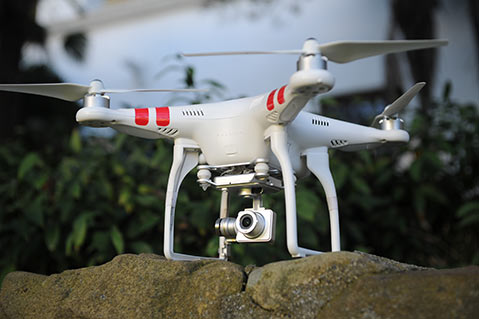
If Eric Foote’s drone could talk, it might borrow a line from an android in Blade Runner: “I’ve seen things you people wouldn’t believe.”
The remote-control eye in the sky has skirted a train barreling up the Gaviota Coast and looked down on paragliders drifting along the Douglas Family Preserve. It’s followed a surfer slicing through glassy ocean above thick kelp forests and trailed a rock climber inching up the Santa Ynez Mountains. It’s flown with pelicans above the Santa Barbara Harbor and peered across a sun-baked city from the Mission’s steeples.
Those moments are neatly packaged in a four-minute movie that played during the Santa Barbara International Film Festival and gave Foote’s new aerial video company its big break. “Things really started taking off,” he said. The former golf instructor had been a photography hobbyist for a long time and now pays the bills with real estate shoots and promo reels for places like Lotusland. With lots of competition in town, “I’m using the drone to carve out a niche,” he explained. “There are so many applications for it.”
But Foote, like thousands of commercial drone operators across the country, including a number in Santa Barbara, has been navigating hazy skies the last few years, as government regulations hadn’t caught up with the new technology. That all changed Sunday when the fog started to lift and the Federal Aviation Administration (FAA), finally acting on orders from Congress in 2012, released its proposal for governing the small commercial aircraft instead of banning them outright.
The proposed rules would allow drones weighing up to 55 pounds to fly below 500 feet and within sight of their pilots during daylight hours. Operators would need to be at least 17 years old, pass an aeronautics knowledge test, and be vetted by the Transportation Security Administration. “We have tried to be flexible in writing these rules,” said FAA Administrator Michael Huerta. “We want to maintain today’s outstanding level of aviation safety without placing an undue regulatory burden on an emerging industry.”
The FAA will start 60 days of public comment on the suggested guidelines, but industry experts predict it will take another year or two before they’re fully ironed out and implemented. In the meantime, commercial use is still outlawed, and operators will keep burying their drone services in contracts, billing for “location fees” and other costs instead of actual flying time.
Luckily for them, the current regulations are open to interpretation and rarely enforced. There have been just five cases to date, and the closely watched prosecution of the pilot who filmed a TV spot over the University of Virginia in 2011 ended out of court this week. The pilot was originally fined $10,000. He wound up paying a $1,100 settlement without admitting any wrongdoing.
The FAA does allow for some commercial use but only with express permission, which it started giving out last year, mainly to Hollywood film studios and crop surveyors. A mere 28 exemptions have been issued with around 350 pending nationwide. Sunday’s announcement doesn’t apply to hobbyists, who are already supposed to follow basic guidelines for model planes and helicopters — stay below 400 feet, avoid populated areas, fly sober, etc. And public entities, such as publicly funded universities, law enforcement agencies, and fire departments are still required to get FAA clearance before they can launch a drone, also called a UAS (Unmanned Aircraft System).
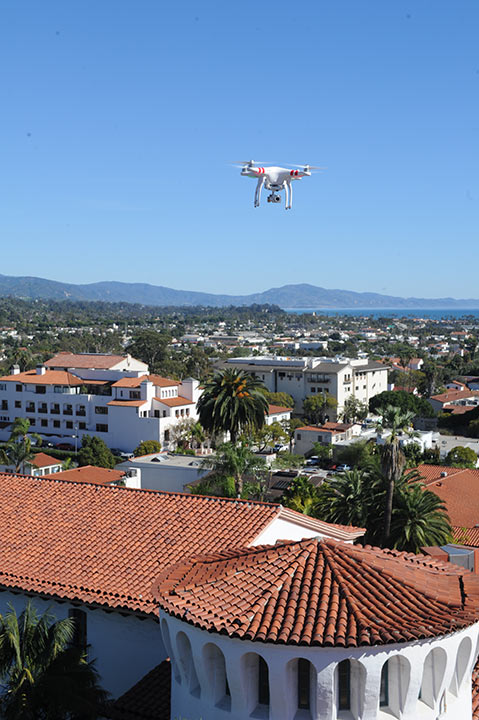
Most trade groups and business interests are applauding the new commercial framework. They’ve long argued that drones are a transformative technology for a whole range of fields like search and rescue, medical support, power line and pipe repair, and wildlife observation. The Association for Unmanned Vehicle Systems International predicts the industry will create 70,000 jobs and $13.6 billion in economic activity in the first three years drones are allowed to fully share the skies. Doorstop deliveries like those envisioned by Amazon.com still wouldn’t be allowed, however.
Also this week, the White House — whose lawn became a symbol of UAS intrusion when a drunkenly flown drone crashed into it last month — issued a memo that orders federal agencies to disclose their drone policies in the next year. Their use along the Mexican border is no secret, but new covert programs are expected to quietly materialize.
Concerns linger across the country over privacy and First Amendment rights. It’s no exception in Santa Barbara, a wealthy and picture-perfect place covered in grand estates, open-air weddings, and scenic vistas that seem to beg for more and more airborne lenses. And the discussion is only gaining momentum as daily reports come in of close calls with crowds and planes and incidents of spying among neighbors.
A recent Reuters poll of 2,400 Americans found that 73 percent of them want more drone regulation; 42 percent oppose all private ownership. In a speech last September, Supreme Court Justice Sonia Sotomayor openly worried about an American dystopia of ever-present surveillance as swarms of cameras take to the sky. “We are in that brave new world,” she said, “and we are capable of being in that Orwellian world, too.”
It’s a Bird! It’s a Plane! It’s a … ?
Up until a few years ago, the word “drone” described a $17 million Predator skulking above Afghanistan. But as the technology was dumbed down for civilian use and prices dipped to consumer levels, the term started to include $50 toys at Brookstone as well as professional-grade units for photographers.
Chinese company DJI makes one of most popular brands. Chances are, if you’ve seen a drone on the job, it’s in the DJI Phantom line that retails between $500 and $1,300. I’ve personally spotted four drones in the last few months — at the Santa Barbara Bowl, East Beach, Isla Vista, and the Mesa. All were Phantoms. And any time there are good waves at Rincon, there’s bound to be one or two overhead.
The DJI models are about a foot and a half wide, weigh 2.5 pounds, go as fast as 30 mph, and sport four propellers above a battery pack and rigid landing gear. Called “quadcopters,” they take off and land vertically and are relatively easy to maneuver with a bit of practice.
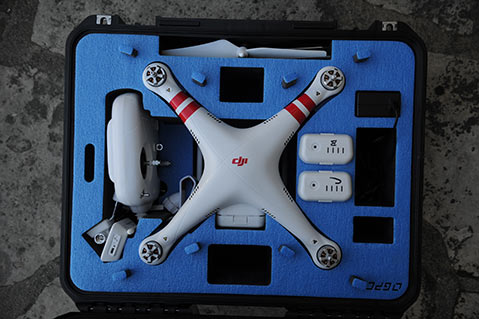
The newest Phantom has a nearly 1,500-foot radio range and can reach an altitude of 1,000 feet. It also has an “autonomous” option where the user enters GPS coordinates on a smartphone and watches as the drone carries out its mission. Other brands can go much higher (above 6,000 feet) and much faster (more than 100 mph.)
Operators used to attach their own GoPros to Phantoms, but the drones now come with a built-in camera capable of beaming videos or stills back to the flyer’s phone in real time. Varieties built more for speed or strength rather than imaging serve cocktails in Singapore restaurants, guide visitors through MIT’s confusing campus, and herd sheep in New Zealand. A cottage industry of accessories and add-ons is big and only getting bigger.
John Brainerd, a manager at Samy’s Camera, said the chain started carrying drones in March 2013. Business has been steady since, and the Santa Barbara store sells several a week. Across the U.S., around 200,000 drones are sold every month. Brainerd said his customers run the gamut from first-time hobbyists to serious photographers because “it’s sort of a kick in the pants. It’s a fun thing to do.”
He recently sold one to a land surveyor who studies cliff erosion and said they’ve been especially popular with off-duty cops. “People in general are enamored by them,” he went on. “They want to talk about them and understand them.” But, Brainerd explained, they come with a lot of risk and liability. “I personally wouldn’t get one,” he said.
The Santa Barbara Independent spoke with a number of photographers about their UAS use on the condition of anonymity. One said he and others find it easy to “fly under the radar” and avoid the FAA, which has started to enlist area police agencies as their eyes and ears for enforcement. While he’s seen a lot of online complaints and “bravado” about snooping over private property, he said anyone who has come across him mid-flight approaches with smiles and questions.
Another source was dubious over protests of peeping from the heavens. He claimed most drone cameras are “very fish-eye” and show little detail and that they sound like a “swarm of bees” when they approach. “You can’t sneak up on someone,” he said. “They have no stealth ability.” That may or may not comfort folks, especially those who’ve had an unexpected face-to-face with a hair-raising UAS.
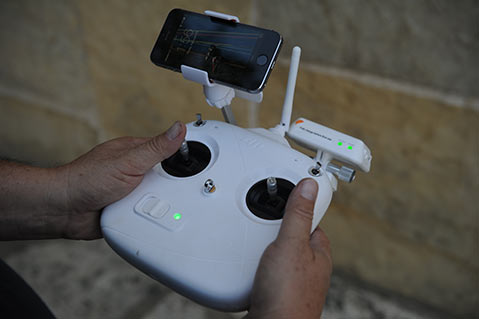
Voyeurs and Violence
State Senator Hannah-Beth Jackson was recently eating dinner with friends on their back patio when a blinking drone came around the corner of the house. She said it hovered near them for about five minutes, a camera trained in their direction. Then it flew off. “It was shocking,” she said. “Unsettling. You think you have a right to privacy there.” Last month, a Mission Canyon resident called The Independent about a similar run-in on her property, and a reporter with our paper had a comparably eerie encounter in his Milpas Street backyard.
Not long after Jackson’s experience, she started looking into drones and quickly realized “there are no rules.” So at the end of January, she introduced Senate Bill 142 that extends existing state laws around privacy and trespassing to the small aircraft. The proposed state regulations are “not designed to be punitive,” Jackson said. “The real purpose is to set expectations and boundaries for what people can and can’t do with respect to these new technologies.”
The new law would address civil matters, meaning a homeowner could sue a drone operator if his or her UAS crossed privacy lines or damaged property. Criminal parameters are already set, but Santa Barbara officials report very few complaints. Residents especially anxious about drones dropping in announced can register their home address with NoFlyZone.org. The brand-new company then relays the GPS coordinates to participating drone manufacturers and creates an invisible “geofence” around the property that keeps the drones away. More than 2,300 customers across California have registered.
Jackson, who is chair of the Senate Judiciary Committee, which oversees legislation on privacy issues, said she wants to avoid an incident like the one in New Jersey when a man shot a UAS out of the sky near his house. Last January, residents of Deer Trail, Colorado, considered issuing licenses to shoot down drones that dared enter their airspace. Plus, they’re dangerous pieces of equipment, Jackson continued, pointing to a fatal accident in Brooklyn two years ago. A 19-year-old lost control of his model helicopter and it sliced off the top of his head. “These things can decapitate people,” Jackson said.
After drones buzzed too close to wildlife and spooked hikers, the National Park Service banned their use. The State Parks department is considering a similar injunction, Jackson said, and law enforcement agencies may make the airspace over their headquarters and jails off limits, as well.
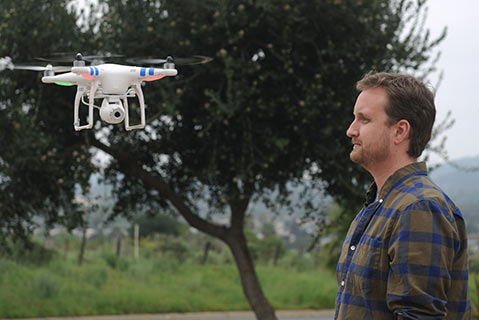
Big Brother Effect
While the FAA has the ultimate authority over goings-on in the air, the county does have some of its own municipal codes, said Santa Barbara Sheriff’s spokesperson Kelly Hoover. Generally speaking, its model aircraft rules extend to all drones, commercial or otherwise. Hoover also said that per FAA policy, “no UAS may be operated within five nautical miles of the Santa Barbara or the Santa Maria airports; it may also include some of the smaller local airports.” Measuring out from the Santa Barbara Airport, that restricts all of Isla Vista and Goleta, big chunks of Noleta, and the western edges of Santa Barbara. Violations carry a fine of $10,000.
Hoover said her office does not track UAS complaints. Santa Barbara Airport director Hazel Johns said her office hasn’t fielded any. And if recent interviews are any indication, when a county deputy or city cop comes across a droner, they most often turn a blind or approving eye on the action.
The Sheriff’s Office doesn’t own or operate a drone in an official capacity, Hoover explained. But she confirmed a department member used his personal UAS during a response call on at least one occasion. On May 29 last year, dispatchers received a 9-1-1 call from a man who claimed to have murdered his wife and children and said he was going to kill himself in their Arroyo Road home.
During the early stages of the incident, which turned out to be a hoax, a “member of the Sheriff’s Office, who personally owned a UAS and had been doing research for the Sheriff’s Office regarding this emerging technology, launched his UAS over the residence briefly in an attempt to gain an aerial view of the residence and property,” Hoover said. The drone was grounded a short time later when a helicopter arrived on the scene to provide surveillance. The department has suspended the use of drones until it develops a complete program and set of policies around the devices, Hoover said.
SBPD spokesperson Sergeant Riley Harwood said the last time he worked Fiesta, the crowd cast nervous glances skyward when a drone started flying patterns over Fiesta Pequeña. “It was moving all herky-jerky, and people thought it might hit them in the head,” he said. Dispatchers, though, rarely take calls about drones, and there’s nothing in the city’s municipal code to deal with them. “[The law] is behind the curve,” Harwood said. The department has explored the idea of buying a UAS, he explained, but that’s as far as it’s gotten because of the agency’s relatively small size and the amount of money and training it would take to designate a pilot.
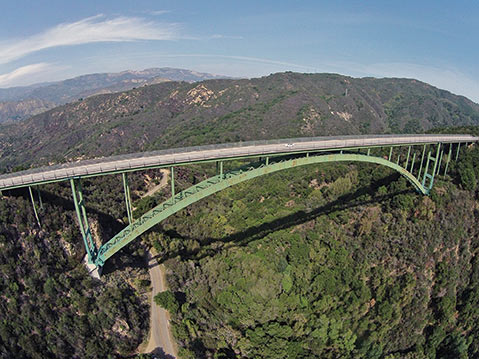
According to the most recent data available from November 2013, approximately 80 law enforcement agencies across the United States have gotten permission from the FAA to deploy drones. Some have toyed with the idea of outfitting them with tear gas, rubber bullets, and tasers.
The County Fire Department was given a Phantom quadcopter, but it’s still sealed in the box and the agency hasn’t yet started the FAA authorization processes, said spokesperson Captain David Sadecki, who indicated that step may be coming soon. The UAS would be launched during emergencies and for training and fire prevention, he said, and a pilot who’s been certified through an FAA ground school and has a Class III medical clearance would fly it. The department already has one such pilot on staff.
Commerce and Kids
Village Properties uses drones to advertise its real estate. So does Berkshire Hathaway and other Santa Barbara firms that declined to be interviewed. Agents said they’re especially useful for large ranch lots and hard-to-reach houses in the Montecito hills. At $500 for a simple photo shoot and up to $3,000 for a full-on film tour, the special treatment is reserved for properties worth $1 million or more.
At the Santa Barbara Bowl, a few acts touring last season brought their own drones to the venue. But since there’s little precedent on liability, and because the ever-moving, LED-lit machines can be distracting for the audience, the Bowl will likely ban them.
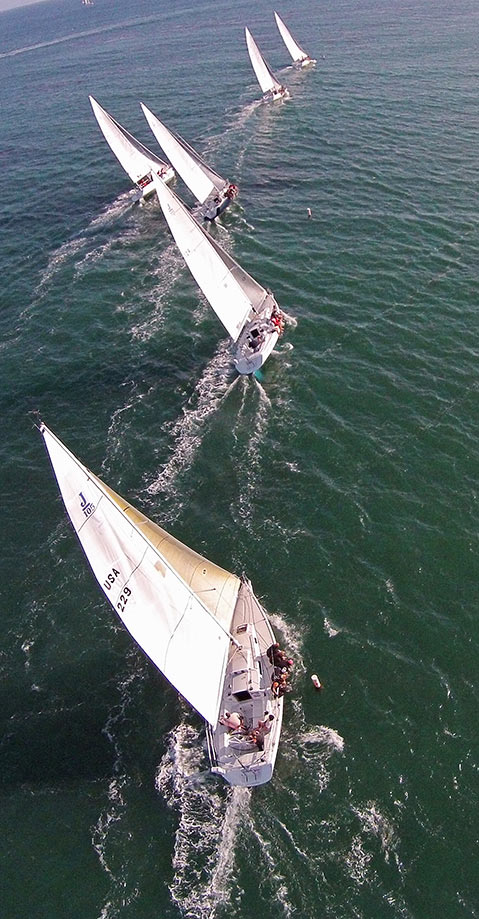
David Baeza, a Santa Ynez Valley resident and former Citrix VP, recently launched a start-up called Vine Rangers. Still in its testing phase but slated to open for business in March, it will be the first company of its kind to survey vineyards with infrared cameras on drones that can measure water saturation and grape ripeness and pick out diseases before the winemaker can.
Because of America’s mushy UAS laws, Baeza said he did most of his research in the U.K. and partnered with an Oxford robotics engineer. With the drought on their minds and one of Santa Barbara’s biggest industries relying on their judgment and yield, winemakers will find drone data invaluable, Baeza said. Vine Rangers has submitted its exemption request to the FAA and will hear back soon. In the meantime, Baeza is partnering with UCSB researchers on their SmartFarm initiative and is hosting the Wine + Tech + Food Conference (WTF Conf) next month.
It’s a mystery how many UCSB faculty members are using drones as part of their research. Since they don’t have to include that info in their applications, it’s almost impossible to tell, said school spokesperson George Foulsham. Several professors are heading projects about air and ocean drones with the goal of making improvements, he said, and those are mentioned in applications about nano-assembled batteries, target localization and tracking, and guidance of unmanned vehicles.
Dos Pueblos High School teacher John Dent runs the school’s DPNews program and purchased a Phantom with grant money about a year and a half ago. The thing was an instant hit. “It has invigorated students who were otherwise not engaged,” he said. “It has made some of our videos wow people.” Beyond that, Dent says the UAS is teaching students an employable skill.
Dent just submitted another application for more drones and hopes to bring in a professional pilot to teach his kids the finer points of flying. Parents collectively dig the program, as well. “It’s all about giving the students a leg up when they graduate high school,” Dent said. And with luck, the concept will catch on at other campuses. “I’m trying to be a pilot program,” he said. “Pun intended.”
‘Drone God’ Has Spoken
Top aviation attorney Mark Dombroff “is kind of drone god,” said one of his colleagues. He’s taken a lead position on the topic in Washington, D.C., and so has an encyclopedic knowledge of where the industry has been and where it’s likely to go. Earlier this month, he spoke to 50 police chiefs at the DoubleTree about their UAS options. (Santa Barbara chief Cam Sanchez didn’t attend.) And he’s firmly abreast of the pending FAA policies, which he said would be enforced by the agency’s Flight Standards District Offices. The closest one to Santa Barbara is in Los Angeles.
On the subject of cops potentially abusing the technology with dishonest surveillance, Dombroff doesn’t share the skepticism many have. “Civil-liberties groups don’t like the idea of the expanded ability to law enforcement,” he said. “But that’s assuming they will misuse [drones], and I don’t think that’s the case.”
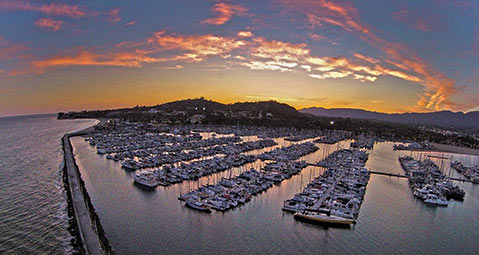
Dombroff has spent much of his career on the legal end of aviation accidents. He was involved in the aftermath of the helicopter crash on the Twilight Zone movie set that killed Vic Morrow and two child actors, and he said the use of small, nimble drones would invariably prevent such accidents and save lives. According to the FAA, 17 manned aircraft performing aerial photography crashed between 2005 and 2009, killing 19 people. Santa Barbara’s own filmmaker Mike deGruy died in 2012 when his helicopter went down during a location scout in Australia.
Drones are already powering a vast new realm of money-making and public-service schemes, Dombroff went on. “The engine is too big to be stopped,” he declared. But he called the pilots who buzz directly over crowds “irresponsible and reckless.” “I don’t know if it’s arrogance or stupidity or both,” he said. And speaking to those who claim that civilian drones are too lightweight to do any real harm, Dombroff said, “Let them take a propeller across the face and see how it feels.”
With regard to all the “hand-wringing and arm waving” over the pending FAA laws — why they’re taking so long, what they will and won’t allow, how they’ll impact professionals, and so on — Dombroff said to relax. “It’s going to be addressed,” he promised. “The self-induced hysteria is unnecessary.”
For the current and hopeful commercial users waiting for regulations to be hammered out, Dombroff had some advice: “File for your exemption right now,” he said. “The line is only getting longer.”



